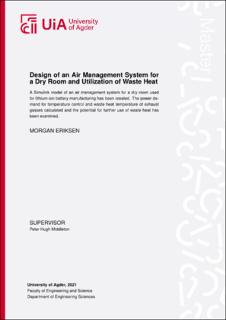| dc.contributor.author | Eriksen, Morgan | |
| dc.date.accessioned | 2021-10-12T07:17:16Z | |
| dc.date.available | 2021-10-12T07:17:16Z | |
| dc.date.issued | 2021 | |
| dc.identifier.citation | Eriksen, M. (2021) Design of an Air Management System for a Dry Room and Utilization of Waste Heat (Master's thesis). University of Agder, Grimstad. | en_US |
| dc.identifier.uri | https://hdl.handle.net/11250/2789119 | |
| dc.description | Master's thesis in Renewable energy (ENE500) | en_US |
| dc.description.abstract | This thesis presents the design of an air management system used in a dry room fora lithium-ion battery factory using a Matlab/Simulink environment. The sizing of the system is based on the 32 GWh battery factory, currently under construction by Morrow Batteries in Arendal, Norway. The generic air management system from the literature review was used as a base for the general layout and initial values. Combining coolers and a desiccant dehumidification wheel was the optimal solution for the dehumidification system. The molecular sieve was the selected desiccant due to its high performance at low relative humidity. The outlet air quality from the dry room, set to avoid chemical reactions with the battery material, is determined where the moisture content is kept constant at 0.44 gr/lb and a temperature between 22 and 25◦C. Baseline simulation for the system uses a structure with the lowest power demand possible whilst maintaining the air quality. Seasonal fluctuations in ambient conditions bring more moisture into the system with the make-up air, causing an increased power demand and air mass flow in the summer. The sizing of the heat exchanger used in the regeneration loop for the desiccant wheel determines the waste heat temperature. The temperature of the waste heat is 42.64◦C as an annual average. The purge rate used in the desiccant wheel is proportional to make-up air and exhaust air, which is a decisive factor for the overall power demand. Further use of this low-grade waste heat depends on local demand and direct use. The use of waste heat for drying wood chips to increase caloric value is a potential solution. | en_US |
| dc.language.iso | eng | en_US |
| dc.publisher | University of Agder | en_US |
| dc.rights | Attribution-NonCommercial-NoDerivatives 4.0 Internasjonal | * |
| dc.rights.uri | http://creativecommons.org/licenses/by-nc-nd/4.0/deed.no | * |
| dc.subject | ENE500 | en_US |
| dc.title | Design of an Air Management System for a Dry Room and Utilization of Waste Heat | en_US |
| dc.type | Master thesis | en_US |
| dc.rights.holder | © 2021 Morgan Eriksen | en_US |
| dc.subject.nsi | VDP::Teknologi: 500::Elektrotekniske fag: 540 | en_US |
| dc.subject.nsi | VDP::Matematikk og Naturvitenskap: 400::Informasjons- og kommunikasjonsvitenskap: 420::Simulering, visualisering, signalbehandling, bildeanalyse: 429 | en_US |
| dc.source.pagenumber | 106 | en_US |

